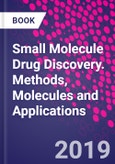Small Molecule Drug Discovery: Methods, Molecules and Applications presents the methods used to identify bioactive small molecules, synthetic strategies and techniques to produce novel chemical entities and small molecule libraries, chemoinformatics to characterize and enumerate chemical libraries, and screening methods, including biophysical techniques, virtual screening and phenotypic screening. The second part of the book gives an overview of privileged cyclic small molecules and major classes of natural product-derived small molecules, including carbohydrate-derived compounds, peptides and peptidomimetics, and alkaloid-inspired compounds. The last section comprises an exciting collection of selected case studies on drug discovery enabled by small molecules in the fields of cancer research, CNS diseases and infectious diseases.
The discovery of novel molecular entities capable of specific interactions represents a significant challenge in early drug discovery. Small molecules are low molecular weight organic compounds that include natural products and metabolites, as well as drugs and other xenobiotics. When the biological target is well defined and understood, the rational design of small molecule ligands is possible. Alternatively, small molecule libraries are being used for unbiased assays for complex diseases where a target is unknown or multiple factors contribute to a disease pathology.
Please Note: This is an On Demand product, delivery may take up to 11 working days after payment has been received.
Table of Contents
1. Synthetic Approaches Toward Small Molecule Libraries 2. Chemical Reactions for Building Small Molecules 3. Chemoinformatics to Assess Chemical Diversity and Complexity of Small Molecules 4. Virtual Screening of Small Molecule Libraries 5. Biophysical Methods for Screening and Characterization of Small Molecules 6. Small Molecule Peptidomimetics:�Principles, Molecules, and Applications 7. sp2-Iminosugars as Chemical Mimics for Glycodrug Design 8. Synthesis and Biological Properties of Spiroacetal-containing Small Molecules 9. Centrocountins: Synthesis and Chemical Biology of Nature Inspired Indoloquinolizines 10. PPIs as Therapeutic Targets for Anti-cancer Drug Discovery: The Case Study of MDM2 and BET Bromodomain Inhibitors 11.�Discovery of Small Molecules for the Treatment of Alzheimer's Disease








